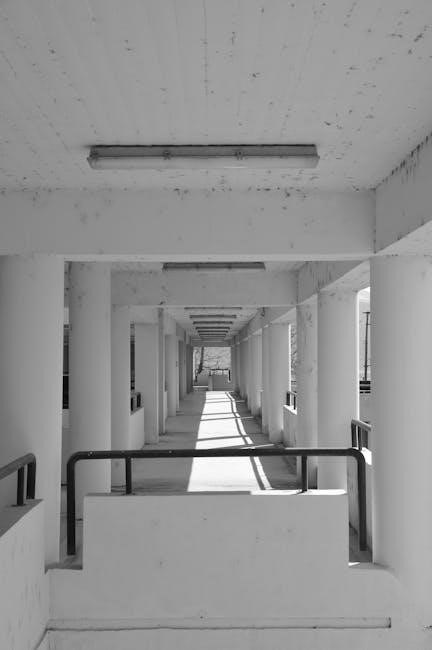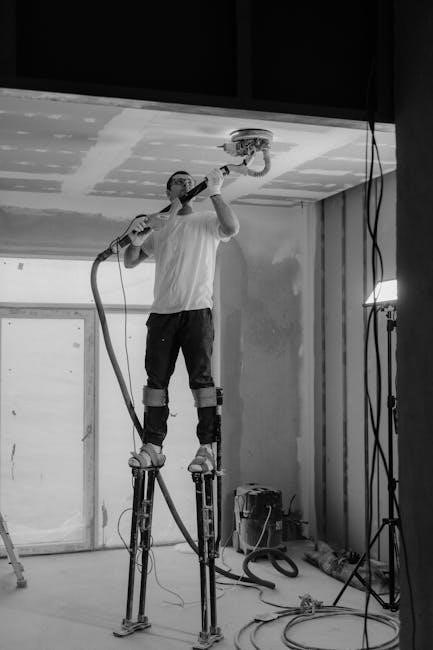Hunter ceiling fans are renowned for their durability, energy efficiency, and sleek designs, offering both functionality and aesthetic appeal for home or office spaces.
This manual provides essential guidance for installation, maintenance, and troubleshooting, ensuring optimal performance and longevity of your Hunter ceiling fan while guaranteeing safety and ease of use.
1.1 Overview of Hunter Ceiling Fans
Hunter ceiling fans are a trusted choice for home and office spaces, known for their durability, energy efficiency, and sleek designs. With over a century of innovation, Hunter offers fans that combine style and functionality, providing year-round comfort. Their fans feature advanced technologies like quiet DC motors and LED lighting, ensuring smooth operation and energy savings. Available in various styles and installation options, Hunter fans cater to diverse decor preferences while maintaining high performance and reliability.
1.2 Importance of the Hunter Ceiling Fan Manual
The Hunter Ceiling Fan Manual is crucial for ensuring proper installation, maintenance, and troubleshooting. It provides detailed instructions for safe setup, optimizing performance, and addressing common issues like wobbly operation or flickering lights. The manual also outlines warranty details and support options, helping users maximize their fan’s lifespan and functionality while adhering to safety guidelines and manufacturer recommendations.
Components and Accessories
Hunter ceiling fans come with essential components like the motor, blades, and mounting hardware. Additional accessories, such as remote controls or light kits, enhance functionality and customization.
2.1 Parts Included in the Box
The box includes the fan motor, blades, mounting hardware, pull chain, and light kit (if applicable). Additional accessories like remote controls or downrods may be included based on the model.
2.2 Additional Tools and Materials Needed
For installation, you’ll need a screwdriver, pliers, and a voltage tester. A ladder is required for ceiling access. Ensure you have wire nuts and connectors for secure wiring connections. These tools are not included in the box but are essential for a safe and proper setup of your Hunter ceiling fan.
Installation Methods
Hunter ceiling fans offer three installation options: low-profile, standard, and angle mounting. Choose based on ceiling height and preference for optimal performance and stability.
3.1 Low-Profile Installation
Low-profile installation is ideal for ceilings with limited space, typically less than 8 feet high. This method uses a shorter downrod to mount the fan closer to the ceiling, ensuring a sleek appearance while maintaining airflow efficiency. It’s perfect for smaller rooms or low-ceiling areas, providing a compact yet powerful cooling solution without compromising style or functionality.
3.2 Standard Installation
Standard installation is suitable for ceilings between 8 to 9 feet high, offering a balanced airflow and stable operation. This method uses a standard downrod to mount the fan at an optimal height, ensuring efficient cooling and circulation. It’s the most common installation type, providing a traditional look while maintaining performance, making it ideal for average-sized rooms and standard ceiling configurations.
3.3 Angle Mounting Installation
Angle mounting installation is ideal for ceilings with slopes or angled surfaces, ensuring proper fan stability and performance. This method requires a specialized mounting bracket to secure the fan at an angle, providing optimal airflow in unique ceiling configurations. It’s perfect for higher or slanted ceilings, maintaining both functionality and aesthetic appeal while addressing specific spatial challenges effectively.

Safety Precautions
Always turn off power at the circuit breaker before installation or maintenance. Ensure the fan is securely mounted to prevent wobbling or accidents.
Follow all electrical safety guidelines to avoid shocks or fires. Never touch electrical components without proper insulation or protective gear.
4.1 General Safety Guidelines
Always turn off power at the circuit breaker before starting installation or maintenance. Ensure the fan is securely mounted to prevent wobbling or accidents. Avoid touching electrical components without proper insulation or protective gear. Keep loose clothing or long hair tied back to prevent entanglement. Use a sturdy ladder and have someone assist for stability. Never operate the fan near water or in humid conditions without proper ratings. Keep children away from the installation area. Read the manual thoroughly and follow all instructions carefully to ensure safety and optimal performance.
4.2 Electrical Safety Tips
Always disconnect power at the circuit breaker before handling electrical components. Use a voltage tester to confirm the power is off. Avoid exposing the fan or its parts to water or moisture. Never overload circuits or use incorrect wire gauges. Ensure all connections are secure and tightly fastened. If unsure about wiring, consult a licensed electrician. Keep electrical components away from children and flammable materials. Follow local electrical codes for safe installation and operation.

Tools Required
Installing your Hunter ceiling fan requires basic tools like a screwdriver, pliers, and a voltage tester. Gather all necessary tools before starting for a smooth process.
5.1 Essential Tools for Installation
To install your Hunter ceiling fan, you’ll need a few essential tools. Start with a screwdriver for removing screws and a voltage tester to ensure wires are safe to work with. Pliers may be necessary for gripping small parts, and a ladder or step stool will provide safe access to the ceiling. Having these tools ready will streamline the installation process and ensure everything goes smoothly.
5.2 Optional Tools for Convenience
For added convenience, consider using a cordless drill for faster screw driving or a second pair of hands to assist with holding the fan. A drop cloth can protect your floors from dust, while a stud finder ensures secure mounting. A wire stripper might also be handy for any wiring adjustments. These tools enhance the installation experience but aren’t required for completing the job successfully.
Step-by-Step Installation Guide
This section provides a detailed, sequential approach to installing your Hunter ceiling fan, ensuring a smooth and efficient process from preparation to final setup.
6.1 Preparing the Ceiling
Before installing your Hunter ceiling fan, ensure the ceiling is structurally sound and can support the fan’s weight. Check for proper ceiling height and clear any obstructions. Turn off the power supply to the area at the circuit breaker. Remove any existing fixtures and inspect the electrical wiring. For high ceilings, consider using a longer downrod for optimal performance. Ensure the ceiling surface is clean and dry for secure mounting.
- Verify ceiling height and structural integrity.
- Ensure power is off at the circuit breaker.
- Remove existing fixtures and inspect wiring.
- Use a longer downrod for high ceilings if needed.
Proper preparation ensures a safe and successful installation.
6.2 Mounting the Fan
To mount your Hunter ceiling fan, begin by installing the mounting bracket onto the ceiling outlet box. Ensure it is securely fastened with the provided screws. Next, attach the fan’s hanger ball to the downrod and align it with the mounting bracket. Gently lower the fan and secure it by tightening the setscrew. For angle or low-profile installations, follow the specific instructions provided in the manual. Ensure the fan is level and firmly fastened to avoid wobbling during operation.
- Install the mounting bracket on the ceiling outlet box.
- Attach the fan’s hanger ball to the downrod.
- Align and secure the fan to the bracket.
- Tighten all screws and setscrews firmly.
- Check the fan’s level and stability.
Proper mounting ensures safe and efficient operation of your Hunter ceiling fan.
6.3 Installing the Light Kit
Start by attaching the light kit to the fan’s housing using the provided screws. Gently insert the glass shades into the kit’s openings and secure them with the retaining rings. Ensure all electrical connections are made according to the manual. Turn off the power before handling any wires. Once installed, test the light to confirm proper operation. This step enhances both illumination and the fan’s aesthetic appeal.
- Attach the light kit to the fan housing.
- Install the glass shades and secure with rings.
- Verify electrical connections are correct.
- Test the light for proper function.
6.4 Connecting the Wiring
Start by turning off the power at the circuit breaker. Connect the black (hot) wire from the ceiling to the black wire on the fan. The white (neutral) wire connects to the white wire. Attach the copper grounding wire to the grounding screw on the mounting bracket. For light kits, follow the manual’s instructions to connect additional wires, securing them with wire nuts or connectors. Finally, install and connect the speed control switch to the wall, linking it to the fan’s wiring harness for remote operation. After completing all connections, turn the power back on and test the fan and lights to ensure everything functions correctly.
- Turn off power at the circuit breaker.
- Connect black, white, and ground wires accordingly.
- Attach grounding wire to the mounting bracket.
- Connect light kit wires as per manual instructions.
- Install and connect the speed control switch.
- Test the fan and lights after completing connections.

Troubleshooting Common Issues
Address wobbling by tightening blade screws or balancing the fan. Fix flickering lights by ensuring proper bulb installation or replacing faulty switches. Consult the manual for detailed solutions.
7.1 Addressing Wobbly Fans
A wobbly ceiling fan can be corrected by tightening loose screws on the blades or the mounting bracket. Ensure all connections are secure and balanced. If the issue persists, check for uneven blade alignment or damaged parts. Refer to the manual for specific balancing techniques and troubleshooting steps to restore stability and smooth operation.
7.2 Fixing Flickering Lights
Flickering lights on your Hunter ceiling fan may be caused by loose connections or incorrect bulb installation. Ensure all bulbs are securely screwed in and compatible with the fan’s specifications. Check the wiring connections in the light kit for tightness. If using a dimmer switch, verify compatibility with the fan’s light system. Refer to the manual for specific troubleshooting steps to resolve the issue and restore consistent illumination.
Maintenance and Care
Regular maintenance ensures optimal performance. Clean blades monthly, balance them for stability, and lubricate moving parts. Inspect for loose screws or wear.
8.1 Cleaning the Fan
Regular cleaning is crucial for maintaining your Hunter ceiling fan’s efficiency and safety; Use a soft, dry cloth to wipe down the blades, motor housing, and light kit. For tougher dust, dampen the cloth with a mild detergent, but avoid harsh chemicals. Always turn off the power before cleaning. Dust accumulation can reduce airflow and cause imbalance, so clean monthly for optimal performance.
8.2 Balancing the Blades
To ensure smooth operation, balance your Hunter ceiling fan blades using the included balancing kit. Attach the weights to the blades one at a time, testing until the fan runs evenly. If wobbling persists, adjust the weights or consult a professional. Proper balance prevents noise, reduces wear, and ensures efficient airflow, maintaining optimal performance and extending the fan’s lifespan.
8.3 Lubricating Moving Parts
Regularly lubricate the bearings and moving components of your Hunter ceiling fan to ensure smooth operation and minimize noise. Use a silicone-based lubricant, applying it sparingly to the motor bearings and hinge pins. Avoid over-lubrication, as it may attract dust and reduce efficiency. Refer to your manual for specific lubrication points and intervals to maintain optimal performance and extend the lifespan of your fan.

Warranty and Support
Hunter ceiling fans come with a comprehensive warranty, ensuring durability and customer satisfaction; Dedicated support teams are available to address queries, providing reliable assistance for optimal performance and longevity.
9.1 Understanding the Warranty
The Hunter ceiling fan warranty ensures comprehensive coverage, typically including a lifetime motor warranty and up to 10 years for parts. This guarantees repairs or replacements for defective components, providing peace of mind. The warranty underscores Hunter’s commitment to quality and customer satisfaction, ensuring your investment lasts while maintaining optimal performance and energy efficiency over time.
9.2 Contacting Hunter Fan Support
For assistance with your Hunter ceiling fan, contact their dedicated support team via phone, email, or through their official website. Representatives are available Monday through Friday to address questions, troubleshooting, or warranty inquiries. Visit their website for detailed contact information and additional resources to ensure your fan operates at its best. Always have your product details ready for efficient support;
The Hunter ceiling fan manual is your key to optimal performance, safety, and longevity. Follow the guidelines for a seamless experience and enjoy years of reliable comfort.
10.1 Summary of Key Points
The Hunter ceiling fan manual provides comprehensive guidance for installation, maintenance, and troubleshooting. It covers various mounting methods, safety precautions, and care tips to ensure optimal performance. Troubleshooting sections address common issues like wobbling or flickering lights. Regular maintenance, such as cleaning and balancing blades, extends the fan’s lifespan. Understanding the warranty and support options ensures peace of mind. Follow these guidelines for years of reliable comfort and efficiency.
10.2 Final Tips for Optimal Performance
For optimal performance, clean your Hunter ceiling fan regularly to prevent dust buildup and ensure smooth operation. Balance the blades to eliminate wobbling and maintain stability. Lubricate moving parts periodically to reduce friction and noise. Always use the correct downrod length for your ceiling height to enhance airflow and efficiency. Follow the manual’s guidelines for installation, maintenance, and troubleshooting to enjoy years of reliable comfort and energy savings.
